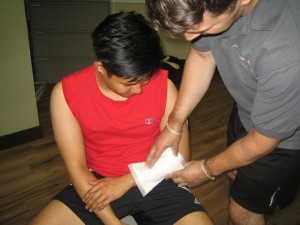Any wound from any poisonous snake or lizard always needs emergency care. If an individual has been wounded by a lizard or snake that is considered poisonous, you have to call for emergency assistance right away and do not wait for the symptoms to manifest. In case you are in doubt on the type of snake or lizard that delivered the bite, you can call poison control immediately to help identify the snake or lizard and the steps to take. Anti-venom is commonly used to counteract the effects of the poison and can save a limb or even a life. While waiting for the medical team to arrive, it is important to calm the individual.
http://youtu.be/_iF-ByukAf8
Poisonous snakes and lizards to watch out for include the pit vipers such as the water moccasin, rattlesnake and copperhead. Coral snakes are also poisonous snakes that can deliver a lethal bite. As for poisonous lizards, it includes the Mexican bearded lizard and Gila monster.
What to expect from a poisonous snake bite

The symptoms of a snake bite from any of the pit viper species often manifest minutes to hours after the bite was sustained. The individual will experience severe burning pain at the bite site that typically starts within minutes and then followed by swelling that starts to spread out from the bite.
Factors that affect the severity of a poisonous snake or lizard bite
The extent of damage of a venomous snake or lizard bite is influenced by the following factors.
- Quantity of venom that was administered (if any)
- Size and type of the lizard or snake
- Strength of the venom that was injected
- Depth and location of the bite
- Age, size and overall health of the individual
- Number of bites sustained and location on the body
If the individual does not develop the symptoms with 8-12 hours, there is a possibility that there was no venom injected which is called as a dry bite. In case poison was injected during a bite, it can be a mild injection of the poison, moderate or severe.
You have to bear in mind that snakes only injects part of its venom in every bite, thus it is still dangerous even after its first bite. Bites from young snakes is considered life-threatening while a snake that is dead with a detached head is still capable of delivering a bite and administer venom based on reflex up to 90 minutes even if it is already dead. If the individual does not manifest the symptoms within 8 hours, you still have to monitor for symptoms for 2 weeks or more.
What to do for non-poisonous snake or lizard bites?
Majority of snakes and lizards are not poisonous. Even though the bites can be frightening, most do not cause any serious health issues. If an individual sustained a bite from a non-poisonous snake, it can leave fang marks, a minor graze or puncture wound without other accompanying symptoms. The first aid measures often relieve the symptoms and helps prevent infection from occurring.
